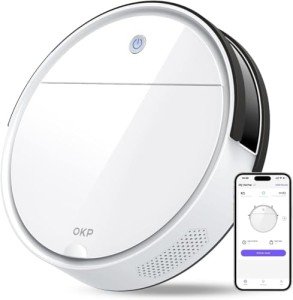
The Evolution and Impact of Robotic Hoovers in Modern Homes
In the ever-evolving landscape of home technology, couple of developments have actually captured the general public's imagination rather like robotic hoovers. These automated cleaning devices, once thought about a high-end, have actually become significantly commonplace in households all over the world. From their simple starts to the sophisticated designs offered today, robotic hoovers have actually revolutionized the way we think of and carry out home chores. This post dives into the history, technology, benefits, robotic Vacuum cleaners uk - review - and possible future advancements of these amazing devices.
A Brief History of Robotic Hoovers
The concept of a robot that might clean autonomously dates back to the mid-20th century, when science fiction authors and futurists began envisioning a future where family jobs would be performed by smart machines. Nevertheless, it wasn't until the late 1990s and early 2000s that the very first commercially viable robotic hoovers hit the market. The iRobot Roomba, introduced in 2002, is typically credited as the pioneer in this field. Because then, many companies have actually gone into the marketplace, each bringing its own unique functions and innovations to the table.
How Robotic Hoovers Work
Robotic hoovers run utilizing a combination of sensing units, algorithms, and navigation systems. Here's a breakdown of the key elements and innovations:
Sensors
- Laser and Infrared Sensors: These assist the robot find obstacles, walls, and drop-offs, guaranteeing it does not fall down stairs or get stuck.
- Dust Detection Sensors: These sensing units identify areas with a high concentration of dirt and dust, permitting the buy robot cleaner to focus its cleaning efforts.
- Cliff Sensors: These prevent the robot from falling off edges, such as staircases.
Navigation Systems
- Mapping Technology: Advanced designs utilize mapping technology to develop a comprehensive layout of the home, optimizing cleaning paths and avoiding previously cleaned locations.
- SLAM (Simultaneous Localization and Mapping): This innovation allows the robot to browse and map its environment in real-time, making changes as it goes.
Cleaning Mechanisms
- Brush Systems: Most robotic hoovers utilize a mix of primary and side brushes to sweep and collect dirt and debris.
- Suction Power: The strength of the suction is essential for reliable cleaning, specifically on carpets and in hard-to-reach areas.
- HEPA Filters: These filters are used in higher-end designs to trap irritants and fine particles, making them perfect for families with animals or allergic reaction sufferers.
Connectivity and Control
- Wi-Fi Connectivity: Many modern-day robotic hoovers can be managed through mobile phone apps, allowing users to set up cleanings, display development, and receive notifications.
- Voice Control: Integration with smart home gadgets like Amazon Alexa and Google Assistant makes it possible for hands-free operation.
Advantages of Robotic Hoovers
The adoption of robotic hoovers has actually brought a number of advantages to modern families:
Convenience
- Automated Cleaning: Robotic hoovers can be set to clean automatically, reducing the need for manual intervention.
- Remote Operation: Users can control and monitor their robotic hoovers from anywhere, using smartphone apps or voice commands.
Efficiency
- Optimized Cleaning Paths: Advanced navigation systems ensure that the robot covers the entire area efficiently, lowering the time and energy needed for cleaning.
- Consistency: Robotic hoovers can carry out cleaning tasks regularly, maintaining a high requirement of tidiness without the need for human supervision.
Cost-Effectiveness
- Long-Term Savings: While the preliminary investment may be greater, robotic hoovers can save cash with time by reducing the need for expert cleaning services.
- Energy Efficiency: Modern models are developed to be energy-efficient, minimizing their impact on electrical power bills.
Time-Saving
- Releasing Up Time: By automating the cleaning process, users have more time to concentrate on other activities, whether it's work, leisure, or spending quality time with household.
Allergic reaction Relief
- HEPA Filters: These filters can capture irritants and fine particles, enhancing indoor air quality and offering relief to allergy sufferers.
Difficulties and Limitations
Despite their many benefits, robotic hoovers are not without their obstacles:
Initial Setup
- Mapping and Calibration: Setting up a robotic hoover can be time-consuming, particularly for larger homes or those with complex layouts.
- Barrier Identification: Users may require to reorganize furniture or eliminate little challenge ensure the robot can browse freely.
Battery Life
- Restricted Range: Most robotic hoovers have a restricted battery life, which might need them to go back to their charging dock before completing a cleaning cycle.
- Frequent Recharging: Some models may require to charge several times throughout a single cleaning session, which can be bothersome.
Cleaning Performance
- Dust and Debris Collection: While efficient on hard floors, some designs battle with deep-pile carpets or heavily soiled areas.
- Upkeep: Regular cleaning of filters and brushes is needed to keep optimum efficiency.
Privacy Concerns
- Information Collection: Some users might be worried about the information collected by the robot, including floor maps and user habits patterns.
Future Developments
The future of robotic hoovers looks appealing, with ongoing developments in innovation and increasing combination with smart home environments. Here are some possible developments:
Enhanced Navigation
- AI and Machine Learning: Improved AI and device knowing algorithms will enable robotic hoovers to better comprehend and adjust to their environment, making them more effective and autonomous.
- 3D Mapping: Three-dimensional mapping technology will permit robotics to navigate more complicated and chaotic areas.
Much Better Cleaning Performance
- Multi-Functionality: Future models may consist of additional functions such as mopping and air purification.
- Smart Sensors: Advanced sensors will detect and tidy specific types of dirt and particles, such as pet hair or sticky compounds.
Improved Battery Technology
- Longer Battery Life: Advances in battery technology will increase the range and duration of cleaning sessions.
- Faster Charging: quicker charging times will lower downtime and make the robotics more easy to use.
Smooth Integration
- Smart Home Ecosystems: Robotic hoovers will integrate more flawlessly with other smart home gadgets, permitting collaborated cleaning and home management.
- Voice-Activated Commands: Enhanced voice recognition and natural language processing will make it simpler to control the robot using voice commands.
Often Asked Questions (FAQs)
How do I set up a robotic hoover?
- Establishing a robotic hoover usually includes downloading a smart device app, connecting the robot to your Wi-Fi network, and developing a map of your home. Some designs might need extra calibration or establishing virtual walls to define cleaning locations.
Can robotic hoovers clean up all kinds of floors?
- A lot of robotic hoovers are developed to clean up both difficult floors and low-pile carpets. Nevertheless, deep-pile carpets and heavily stained areas may need extra cleaning or a more effective design.
How typically do I need to empty the dustbin?
- The frequency of emptying the dustbin depends on the size of your home and how frequently the robot cleans. As a basic rule, it's a good idea to clear the dustbin after each cleaning session to ensure optimum efficiency.
Are robotic hoovers noisy?
- Modern robotic hoovers are designed to be relatively quiet, but the sound level can vary depending on the design and the strength of the suction. Some models use a "peaceful mode" for very little disturbance.
Can robotic hoovers climb stairs?
- The majority of robotic hoovers are not developed to climb stairs due to security concerns. Nevertheless, some designs can be set to stop briefly at the top of a staircase and resume cleaning on a different floor once manually moved.
Do I require to remove furnishings before using a robotic hoover?
- While some furniture may need to be moved to allow the robot to clean below, the majority of models are designed to navigate around barriers. It's a great concept to get rid of small items that could impede the robot's path.
How long do robotic hoover and mop hoovers last?
- The lifespan of a robotic hoover can vary, but numerous models are designed to last a number of years with correct maintenance. Regular cleaning of filters and brushes, along with keeping the robot's software application updated, can extend its life-span.
Are robotic hoovers worth the investment?

- For many households, the convenience, efficiency, and time-saving advantages of robotic hoovers make them a beneficial financial investment. However, it's important to consider your specific requirements and the functions used by different models before buying.
Robotic hoovers have come a long method because their beginning, changing the method we maintain our homes. With their capability to clean autonomously, incorporate with smart home systems, and provide constant results, they offer a variety of benefits that make them an appealing choice for lots of families. As innovation continues to advance, we can expect much more sophisticated and easy to use designs to emerge, further improving the cleaning experience. Whether you're a hectic expert, a parent, or simply someone who values a tidy home, a robotic hoover may simply be the option you've been looking for.
By exploring the history, innovation, advantages, and future of robotic hoovers, this post intends to provide a comprehensive understanding of these ingenious cleaning devices. For those considering a robotic hoover, the FAQs and lists of essential features can function as important resources in making an informed choice.








